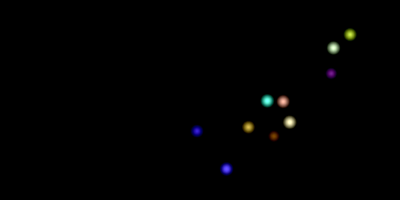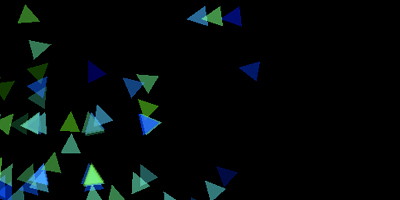No Copy Paste
live coding practice is an emerging field in contemporary digital performance culture. we have made several performances in~ and outside of the field with the no copy paste collective.
several performances can be observed at the no copy paste website.
particle dance with gem & sensors

Creating a particle system, route and store their individual x position via dynamic patching. This data is then used to check collision with a line. Particle dance direction can be set by accelerometer (if you run an apple laptop).
Built with Pd-extended 0.42 download source: Particledance.zip
swarming nodes

This example demonstrates a mouse-following behaviour within the GEM window. The nodes create different sounds, according to their positions.
Important feature of their behaviour is that they know each other`s position by storing and
reading them using an array. They try to keep distance from each other, while trying to follow the mouse position.
Built with Pd-extended 0.40.3 download the source
rotating elements with gem [pd]

visual example for dynamic object creation
Recently i`ve been interested in extending patching possibilities and trying to generate more instances
of the same abstraction.
This example is about rotating elements (the same abstractions ) towards the mouse within the GEM window. The elements are behaving the same way, they are moving semi-randomly around the window while pointing towards the cursor.
Built with Pd-extended 0.40.3 download the source
language is a virus
“The cut-up is actually closer to the facts of perception than representational painting. Take a walk down a city street and put down what you have just seen on canvas. You have seen a person cut in two by a car, bits and pieces of street signs and advertisements, reflections from shop windows - a montage of fragments. Writing is still confined to the representational straitjacket of the novel … consciousness is a cut up. Every time you walk down the street or look out of the window, your stream of consciousness is cut by random factors.”
The cutup is a mechanical method of juxtaposition in which Burroughs literally cuts up passages of prose by himself and other writers and then pastes them back together at random. This literary version of the collage technique is also supplemented by literary use of other media. Burroughs transcribes taped cutups (several tapes spliced into each other), film cutups (montage), and mixed media experiments (results of combining tapes with television, movies, or actual events). Thus Burroughs’ use of cutups develops his juxtaposition technique to its logical conclusion as an experimental prose method, and he also makes use of all contemporary media, expanding his use of popular culture.